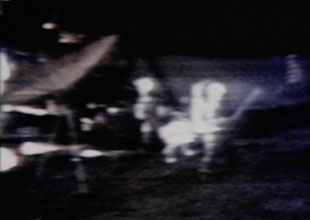|
|

|
Apollo 14 explorations continue (part three)
by Andrew Chaikin, author A Man On The Moon
February 6, 2001

Alone aboard the command module Kitty Hawk in lunar orbit, Stu Roosa was having a difficult time. For one thing, his flight plan was so crowded with tasks that he barely had time to grab a bite to eat. To make matters worse, the high-resolution Hycon camera malfunctioned after taking 140 photos, and Roosa had to spend much of his time trying to fix it, putting him way behind schedule. The failure of the Hycon camera jeopardized one of Roosa's most important tasks, taking pictures of a proposed landing site for Apollo 16. In the end, Roosa had to take the pictures using a regular camera equipped with a telephoto lens, turning the spacecraft to keep the target in sight as he flew over.
With such pressures on him, Roosa barely had time to take in the experience of his solo voyage in lunar orbit. But there were moments, particularly while flying through night over the lunar far side, out of radio contact with Earth, when the cabin would turn cool and slightly clammy, and Roosa could practically feel the darkness. In those moments he understood what it meant to be totally alone. Then, shortly before regaining contact with Mission Control, there was an explosion of light as the Sun appeared, lifting his spirits and warming Kitty Hawk's cabin. And every once in a while, he heard about the progress of his two crew mates down on the surface, roaming the Fra Mauro highlands. Maybe they were having an easier time than he was.
For Al Shepard and Ed Mitchell, though, Apollo 14's second Moonwalk, begun early on February 6, didn't go as they expected. Like the first excursion the previous day, bouncing around in the Moon's one-sixth gravity was a delight. And it was utterly exhilarating to walk on ground that had never been seen before by human eyes. But the two explorers found, as they began their climb up the flank of Cone Crater, that getting around on the Moon could be utterly frustrating.
With no familiar landmarks -- no trees or buildings -- the men had trouble judging distance. A rock up ahead could be 50 feet away or 500. They had brought along a photo map of the area, but the undulating terrain, resembling desert sand dunes, confused their efforts to locate any recognizable features. Each time they came over a rise, expecting to see the rim of the giant crater, they saw only an expanse of ridges and rocks.
And the climb proved tiring, not only because of their stiff, pressurized spacesuits, but because they were pulling a three-wheeled tool cart, now laden with lunar rock samples. In Mission Control, NASA doctors looked anxiously at the astronauts' heart rates. Mindful of Shepard and Mitchell's limited oxygen supply, and the long walk back to the safety of their lunar module, Mission Control called an end to their hunt for Cone Crater's rim. Minutes later, after collecting a few more rock samples, Shepard and Mitchell were bounding down the hillside in long, loping strides, heading for their lunar module Antares. Still ahead was the liftoff from the Moon, the linkup with Roosa in lunar orbit, and the trip back to Earth.
In Shepard's mind, Apollo 14 had hit the mark. He would return home with the satisfaction of having proven himself, and helping to score a success for Apollo. The rocks he and Mitchell had gathered would prove to be among the oldest ever returned from the Moon. And Roosa's photographs and observations would add to the growing body of knowledge on Earth's nearest neighbor in space.
Before climbing back into the lander, however, Shepard had an "experiment" that wasn't in the flight plan. He'd gotten the idea one day during training, when Bob Hope visited the space center. Shepard accompanied the famous comedian as he tried out a lunar-gravity simulator -- all the while holding onto his trademark golf club. That's when Shepard, himself an avid golfer, hatched his plan. Now, standing before the television camera, he addressed his audience on Earth: "In my left hand, I have a little white pellet that's familiar to millions of Americans." Shepard wielded a makeshift golf club, made from a six-iron head attached to a sample-collection tool handle. In his pressurized suit he could only manage a one-handed swing. But after a couple of tries, Shepard managed to connect with the ball, which went sailing away in the Moon's one-sixth gravity. While the world listened, Shepard exulted, "Miles and miles!" Alan Shepard had become the first lunar golfer, and no one minded if he exaggerated just a bit.
The preceding article first appeared on SPACE.com. It is reprinted with permission. |
back to News

© 2023 collectSPACE.com All rights reserved.
Questions? E-mail contact@collectspace.com

|
|

|

|
